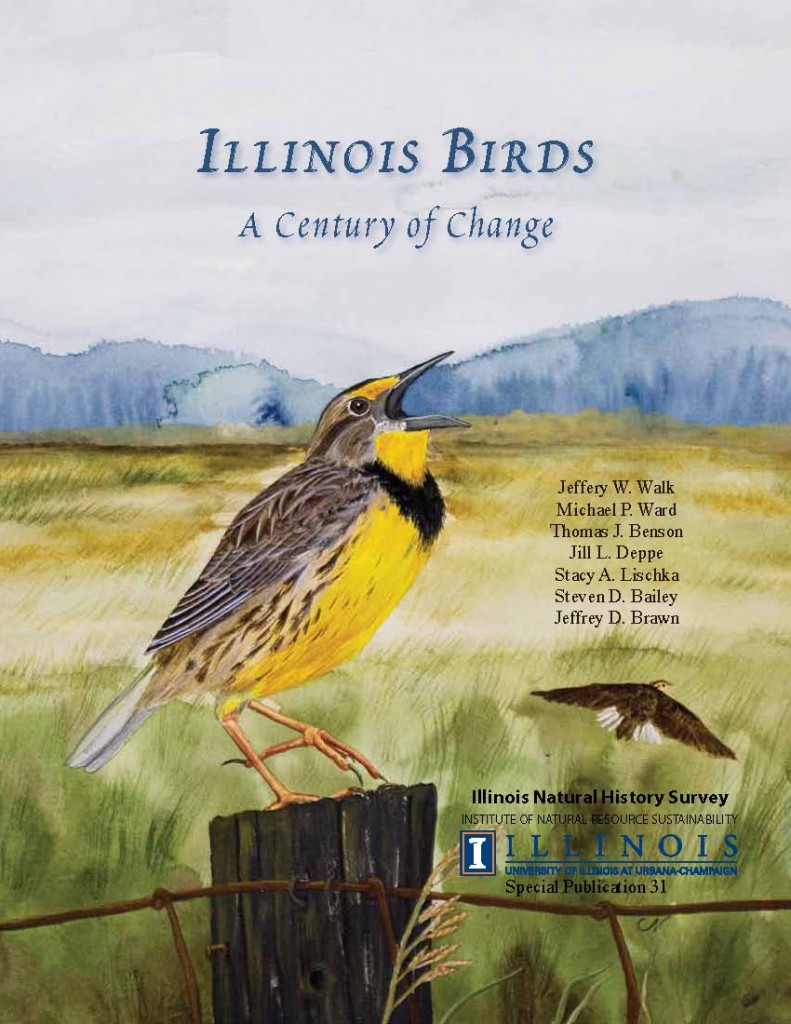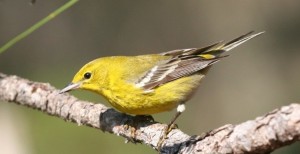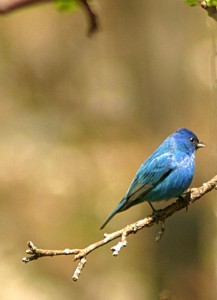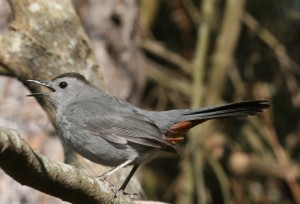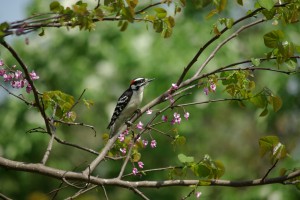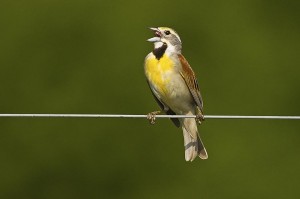New Book Chronicles Changes Among Illinois’ Birds and Habitats
The recent release Illinois Birds: A Century of Change, by Jeff Walk, Mike Ward, TJ Benson, Jill Deppe, Stacy Lischka, Steve Bailey, and Jeff Brawn is a milestone work that offers a masterful treatment of avian population changes through time. Bird population studies constitute an important methodology to assess the quality and quantity of change to Illinois’ varied landscape and are a direct measurement and indicator of the health and wealth – or decline and poverty − of wildlife habitats.
Unlike the snapshot in time of the familiar canary-in-the-coal-mine analogy, Walk et. al. have produced a study that includes change through time, a picture of landscapes past and potential avian and human futures. Illinois possesses a century of comprehensive bird survey data that the authors have compiled and analyzed.
The very first systematic bird survey in North America was the 1906-1909 study by Alfred Gross and Howard Ray. Selecting areas of varied habitat type in northern, central, and southern Illinois, they inventoried birds seen during steadily-timed walks through transect patterns of generally 50 yards wide and 100 yards long. Fifty years later, in 1956-1958, Drs. Richard and Jean Graber carefully reprised the bird survey. And, in 2007-2009, Walk, Ward and several of their co-authors repeated the survey for the third time. Their resulting analysis of all three surveys, coupled with a solid treatment of land cover and use, contains both verification of obvious alterations and a number of counterintuitive surprises, defying conventional wisdom on what we think has changed on the state’s landscape, and provides a significant chain of evidence to answer our questions about where some of our birds have gone.
Walk et. al., document these trends through a well-ordered presentation of charts, graphs, and tables. Most strikingly, the authors’ use of comparative aerial photography from the 1950s and 2007 visually demonstrates the dramatic alterations in Illinois’ landscape that underlie many changes in Illinois’ bird populations and their occurrence across the state.
That urban and suburban development has dramatically altered land cover over the last century comes as no surprise. In 1907 urban residential areas in Illinois accounted for 350,000 acres; urban / suburban acreages were 820,000 in 1957; at present 1.6 million acres in the state are high- or low-density developed areas.
The increase in forest cover in Illinois, as the authors note, is counterfactual to the conventional wisdom of disappearing woodlands. In the early 1900s there were 3 million acres of forest in the state, 4 million acres by mid-20th century, and 5.2 million acres today. In the last 50 years, forest cover has increased 68% in northern, 22% in central, and 5% in southern Illinois.
Certainly of no surprise is the decline of grasslands in Illinois. Even at the time of the first bird survey the “prairie state” no longer existed, as native prairies were long gone, converted to agriculture by the mid-1800s. The authors’ thoughtful discussions and analysis of alterations in agricultural practices — land use – provide great insight into our changing avian populations.
The detailed accountings of 44 species, chosen as representative suites of the state’s avian population, includes data on distribution, abundance, habitat, and changes over the past century both in Illinois and across species’ entire ranges. Supplementing the data from the three statewide surveys with the annual trend analysis provided by the 1966-2007 Breeding Bird Surveys, the authors present patterns of change and prospects for the future.
What’s changed? Canada geese, unobserved during both the 1900s and 1950s surveys, now are among the most common birds. Similarly, Cedar Waxwing populations have grown at an almost exponential rate. Bewick’s wrens, all but extirpated now, were the most common wren observed during the 1906-1909 survey. But stability also is part of the story, as, for example, Mourning Dove populations and rates of occupancy throughout the state have remained unchanged. Similarly, trends for forest dependent species also indicate stability.
As individual “winners” and “losers” offer clues, the authors’ analysis of groupings of winners and losers offers hypothesis. Species once dependent upon native prairies and savannah habitats adapted to the human-created alternates of hayfields and pasturage; yet, many of these same species have experienced dramatic recent declines and even population crashes, such as Upland Sandpipers and Loggerhead Shrikes. The economies of scale of modern agricultural production has resulted in consolidation of both farms and fields and, as agriculture has simplified across Illinois, with fewer but much more intensively produced types of crops, so too the number of avian species on agricultural lands has been radically simplified.
Winners may be more adaptable to the rapid changes humans make on the landscape, with Chipping Sparrows, for example, apparently more able to shift from their native shrub/grassland habitat to suburban/exurban environments. Field Sparrows, exhibiting population declines that may place them on the loser list, simply may not be able to adapt to the loss of farm field hedgerows and mixed agricultural practices that had served as substitutes for native prairie and shrubland habitat. And, in an ironic joke played on those engaged in campaigns against invasive plants as a means of improving wildlife habitat, a few avian species owe their success to these very plants. Cedar Waxwing populations may be a conservationist’s nightmare of a feedback loop as this species takes advantage of the high berry production of non-native invasive plant species, such as bush honeysuckle, to both increase its own and the unwanted plants’ population and range.
In the concluding pages of the work, the authors go out on a line and make a few predictions about the state of the birds in the state in 50 more years. Bobolinks, Whip-poor-wills, Upland Sandpipers, Loggerhead Shrikes, Common Moorhens, and Red-headed Woodpeckers are predicted for extinction in Illinois. On the positive side, they predict increases in Swallow-tailed Kites, Black-bellied Whistling-Ducks, Red-shouldered Hawks, Trumpeter Swans, Blue Grosbeaks, and Fish Crows.
In the final analysis, the most important component for the future of birdlife in Illinois is the willingness of people to conserve and preserve the natural heritage we have remaining and to decide if our humanscape will accommodate greater or lesser numbers of birds – of all wildlife – as neighbors and co-inhabitants of our state.
Illinois Birds: A Century of Change is a 230-page, full-color book, published by the University of Illinois. It is available for $25.00, plus shipping, from the Illinois Nature History Survey publications division. Copies can be ordered by mail (Publications Office, INHS, 1816 South Oak St., Champaign, IL 61820); by telephone (217-244-2161): by e-mail (pubs-sales@inhs.uiuc.edu); or through the INHS online store (https://shop.inrs.illinois.edu/shop-inhs.html).
But The More Things Change…….
While Walk, et. al., certainly succeed in showing a century of change in bird populations, their work also could be subtitled “A Century (and a Half) of Continuity in Illinois Scientific Endeavor,” for this work highlights the long tradition of scientific excellence in the state.
From its founding in 1858 by a small group of educators and naturalists at the University of Illinois as the State Laboratory of Natural History, the Illinois Natural History Survey has evolved to become the most preeminent state biological survey in the United States. For 152 years, INHS has continued to perform comprehensive surveys of biological resources, maintain a complete and representative collection of our state’s plants and animals, and conduct biological research on a variety of topics of use to the people and commerce of Illinois.
The Survey’s 2009 publication, Canaries in the Catbird Seat, is another milestone study of the state of the state of nature in Illinois. Editors Christopher Taylor, John Taft and Charles Warwick draw together research from the spectrum of biological inquiry, embedded within a wealth of historical analysis, offering a view of Illinois’ past, present, and potential future. Like Walk, et. al., these authors leave open the question of “sustainability” of Illinois’ biological landscape. In so doing they point to a new pragmatism in science and, perhaps, to a healthy disconnect between the science of a century ago and the science practice of the present and future.
Both Illinois Birds and Canaries give bonuses to readers of the history of science. Discussions, particularly of methodology, pinpoint change in science practice and in scientists’ beliefs about capabilities. Steven Forbes, Director of the State Laboratory of Natural History from its founding in 1858, exemplifies the positivist, even heroically infallible, view of science at the turn of the 20th century with his views of methodological perfection. Techniques used by the field observers conducting the first bird survey were so well designed, Forbes reported, that “…nothing can escape the meshes of their well-trained observation,” (quoted in Walk, et. al., p.11). Walk and his co-researchers note not only their alterations to Forbes’ methodology but, more importantly, their work showcases the need to continually check and recheck assumptions and preconceived simplistic answers.
Clifftop, a local nonprofit organization, is focused on preserving and protecting area bluff lands.
Versions of this article appeared in the January 7 2011 Monroe County Independent and in the Spring 2011 edition of Illinois Audubon Magazine.
© 2011 all content rights reserved, Clifftop NFP.
Comments are currently closed.

